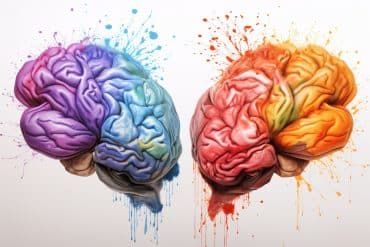Summary: A new study examines cooperative behavior through the classic game Pacman. The experiment involved two players guiding Pacman collaboratively, with one player seeing the maze path and communicating directions indirectly.
Using EEG to measure event-related potentials, the study observed enhanced brain reactions (P3 component) linked to game roles and cooperative decision-making.
This research highlights the brain’s adeptness at adopting roles in cooperative scenarios and provides new insights into cognitive neuroscience.
- The study used Pacman as a natural medium to examine cooperative behavior in a structured EEG lab setting, requiring players to work together to navigate the game.
- EEG measurements showed increased P3 component responses when players received or observed relevant game symbols, indicating the brain’s dynamic response to cooperative roles.
- The findings emphasize the brain’s inherent capacity for role adoption in cooperative tasks, a fundamental aspect of societal structures.
Source: University of Konstanz
Intense focus pervades the EEG laboratory at the University of Konstanz on this day of experimentation. In separate labs, two participants, connected by screens, engage in the computer game Pacman.
The burning question: Can strangers, unable to communicate directly, synchronize their efforts to conquer the digital realm together?

Doctoral candidate Karl-Philipp Flösch is leading today’s experiment. He states: “Our research revolves around cooperative behaviour and the adoption of social roles.”
However, understanding brain processes underlying cooperative behaviour is still in its infancy, presenting a central challenge for cognitive neuroscience.
How can cooperative behaviour be brought into a highly structured EEG laboratory environment without making it feel artificial or boring for study participants?
Pacman as a scientific “playground”
The research team, led by Harald Schupp, Professor of Biological Psychology at the University of Konstanz, envisioned using the well-known computer game Pacman as a natural medium to study cooperative behaviour in the EEG laboratory.
Conducting the study as part of the Cluster of Excellence Centre for the Advanced Study of Collective Behaviour, they recently published their findings in Psychophysiology.
“Pacman is a cultural icon. Many have navigated the voracious Pacman through mazes in their youth, aiming to devour fruits and outsmart hostile ghosts”, reminisces Karl-Philipp Flösch. Collaborating with colleagues, co-author Tobias Flaisch adapted the game.
In the EEG version, two players instead of one must collaboratively guide Pacman to the goal. Flaisch explains: “Success hinges on cooperative behaviour, as players must seamlessly work together.”
However, the researchers have built in a special hurdle: the labyrinth’s path is concealed. Only one of the two players can see where Pacman is going next.
Flösch elaborates: “The active player can communicate the direction to the partner, but only indirectly using pre-agreed symbols, communicated solely through the computer screen.”
If you do not remember quickly enough that a crescent moon on the screen means that Pacman should move right, and that only the banana on the keyboard can make Pacman move to the right, you’re making a mistake.
“From the perspective of classical psychological research, the game combines various skills inherent in natural social situations”, notes Harald Schupp.
EEG measures event-related potentials
During each game, the players’ brain reactions were measured using EEG. Calculating event-related potentials provides a detailed view of the effects elicited by different game roles with millisecond-level temporal precision.
The team hypothesized that the game role significantly influences brain reactions. Therefore, they examined the P3 component, a well-studied brain reaction exhibiting a stronger deflection in the presence of significant and task-relevant stimuli.
The results confirmed their assumption: “The P3 was increased not only when the symbol indicated the next move’s direction but also when observing whether the game partner selected the correct symbol”, says Flösch.
The team concludes that the role we take on during cooperation determines the informational value of environmental stimuli situationally. EEG measurements allow the brain processes involved to be dynamically mapped.
“Cooperative role adoption structures our entire society”, summarizes Schupp, providing context for the study.
“An individual achieves little alone, but collectively, humanity even reaches the moon. Our technological society hinges on cooperative behavior”, says Flösch, adding that children early on take individual roles, thereby learning the art of complex cooperation.
Consequently, this role adoption occurs nearly effortlessly and automatically for us every day.
“Our brains are practically ‘built’ for it, as evidenced by the results of our study.”
About this cooperative gaming and neuroscience research news
Author: Helena Dietz
Source: University of Konstanz
Contact: Helena Dietz – University of Konstanz
Image: The image is credited to Neuroscience News
Original Research: Open access.
“Dyadic cooperation with human and artificial agents: Event-related potentials trace dynamic role taking during an interactive game” by Karl-Philipp Flösch et al. Psychophysiology
Abstract
Dyadic cooperation with human and artificial agents: Event-related potentials trace dynamic role taking during an interactive game
Humans are highly co-operative and thus cognitively, affectively, and motivationally tuned to pursue shared goals. Yet, cooperative tasks typically require people to constantly take and switch individual roles. Task relevance is dictated by these roles and thereby dynamically changing.
Here, we designed a dyadic game to test whether the family of P3 components can trace this dynamic allocation of task relevance.
We demonstrate that late positive event-related potential (ERP) modulations not only reflect predictable asymmetries between receiving and sending information but also differentiate whether the receiver’s role is related to correct decision making or action monitoring.
Furthermore, similar results were observed when playing the game with a computer, suggesting that experimental games may motivate humans to similarly cooperate with an artificial agent. Overall, late positive ERP waves provide a real-time measure of how role taking dynamically shapes the meaning and relevance of stimuli within collaborative contexts.
Our results, therefore, shed light on how the processes of mutual coordination unfold during dyadic cooperation.






